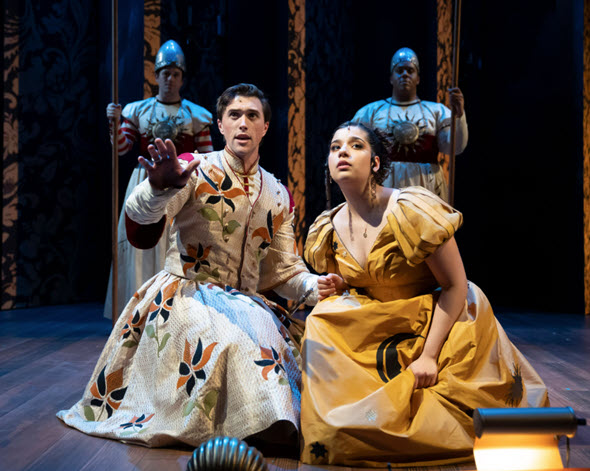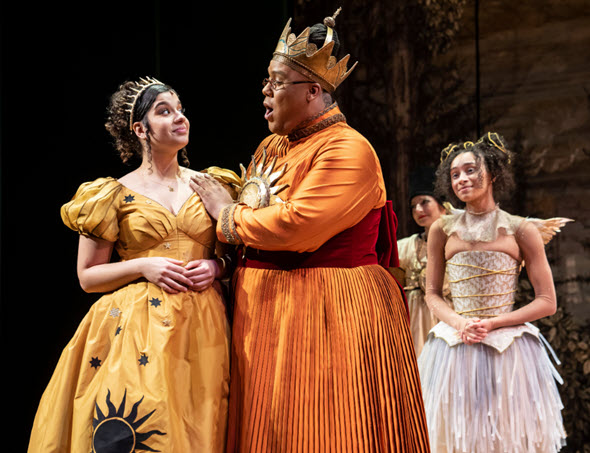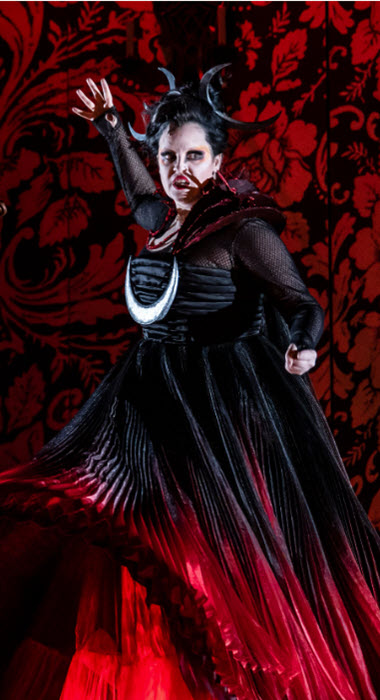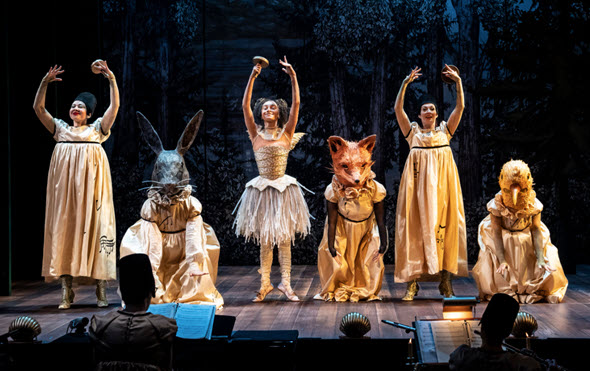‘Matchbox Magic Flute’ at Goodman Theatre: Mozart’s opera spun afresh in a whimsical key
Review: “Matchbox Magic Flute,” created and directed by Mary Zimmerman after Mozart, at the Goodman through March 24. ★★★★
By Lawrence B. Johnson
Director Mary Zimmerman’s take on Mozart’s opera “The Magic Flute” at Goodman Theatre falls somewhere between the work’s original conception as a “singspiel,” literally a sung play, and a sort of heedless “Hey, guys, let’s put on a musical.” Only here and there does it get its chin above the opera bar, and yet it is altogether delightful, a rambunctious good time. And it has one of the best dragons ever.

Tamino (Billy Rude) and Pamina (Marlene Fernandez) are destined for each other, and for spiritual transformation.
Zimmerman, an ever-imaginative storyteller and inexhaustibly inventive director, calls her version of the tale “Matchbox Magic Flute,” perhaps because it is scaled way down but doubtless also because it was intended for spaces much smaller than the houses of grand opera. For that matter, “The Magic Flute,” which first saw the light shortly before Mozart’s death in 1791 at age 35, was created for just such intimate presentation. And while the opera – OK, singspiel – was meant for formidable voices mostly missing here, it seems very likely the fun-loving Mozart would have embraced Goodman’s enterprise with warm approval.
The mystical story of “The Magic Flute” involves the handsome Prince Tamino who finds himself lost in a strange land and narrowly escapes death in the maw of a hideous serpent. He is saved by three female attendants of the Queen of the Night, though credit for the rescue is claimed, at least momentarily, by a dopey bird-catcher called Papageno. The starry Queen has chosen Tamino to rescue her daughter Pamina from the lair of her father Sarastro, the leader of a religious cult – or philosophical brotherhood – who has kidnapped the girl.
When Tamino sees a portrait of Pamina, he’s smitten and accepts the challenge – with the hapless Papageno as his wing man. To ensure their success, the Queen’s agents bestow on Tamino a magic flute and on Papageno magic bells. The music of these charmed instruments will get them out of perilous predicaments. Though this unlikely twosome begin their adventure together, they are soon separated, and thereby hangs much of the tale. Ultimately, Tamino and Pamina will undergo trials to determine their fitness as royal heirs to Sarastro’s realm.
What to say about this loopy enterprise? Perhaps first that, as a music critic of long experience and witness of many actual “Magic Flutes,” I had no idea what this would look like or sound like – or why Goodman was tackling opera at all. In short order, though, I was rolling with “Matchbox Magic Flute” as a sort of vaudeville arabesque. The orchestra, five musicians in antique Middle Eastern costumes, was arrayed facing the stage: percussion, piano, flute, violin, cello. Very fine musicians, all.
It’s the let’s-make-a-musical spirit of this mad romp that pulls you in. Mostly, this is not a grand night for singing. It’s a great night for wacky entertainment. Anyone who knows “The Magic Flute” looks immediately for the birdbrained Papageno, one of Mozart’s most endearing characters and a wonderful baritone role. Shawn Pfautsch is maybe a spinto tenor, but he pours himself into the role of the simple, innocent Papageno in a performance stuffed with charm, heart and idiocy. By contrast, Billy Rude’s cardboard cutout version of Prince Tamino offers a tall, pleasing figure, but he brings so little presence to the proceedings that Tamino all but vanishes. Ah, well, one could argue that the story isn’t really about the prince anyway.
For operaphiles, “The Magic Flute” is very much about the Queen of the Night, to whom Mozart gave two breathtakingly brilliant and staggeringly difficult arias. You can finesse other aspects of the story, but without a Queen of the Night who can actually sing the part, you don’t have anything. As it turns out, she’s not a nice person, but her music is spectacular. Zimmerman and Goodman found their Queen in soprano Emily Rohm, who delivered the vocal goods in astonishing fashion. I was surprised at her first aria, amazed at the second.
The music – the singing – really does matter in “The Magic Flute,” and it’s quite variable in this matchbox adaptation. Marlene Fernandez is a lovely Pamina, a sympathetic character with a well-schooled soprano voice. But what Goodman audiences will not experience is one of the opera’s sublime moments, a mutually empathic duo in which Pamina and Papageno sing about the profound meaning of love: In the original German, “Bei Männern, welche Liebe fühlen,” or Men who feel the call of love. Beethoven was so moved by Mozart’s air that he composed a set of variations on the tune for cello and piano. Here, Pfautsch couldn’t provide the vocal depth to complement Fernandez’s radiant Pamina.
As the majestic and imperious Sarastro, another imposing vocal part in the original, Keanon Kyles displayed an august stage presence not entirely equaled by his vocal means. Similarly, Russell Mernagh cavorted menacingly enough as Sarastro’s lustful, here quite Caliban-like, servant Monostatos, but again didn’t meet the assignment with commensurate voice.
Two perfect delights are Lauren Molina as Papagena, the pining bird-catcher’s long-sought nesting partner, and Reese Parish as the Spirit, a blithe flitting creature who steers the action and slyly reminds the viewer of what’s going on.
Todd Rosenthal’s almost artless sets are just right for this unpretentious telling, and Ana Kuzmanic’s fanciful costumes only enhance the magic – right down to the clutch of forest creatures who, for a brief ineffable moment, make us all 6 years old again.
Related Link:
- Performance location, dates and times: TheaterInChicago.com





